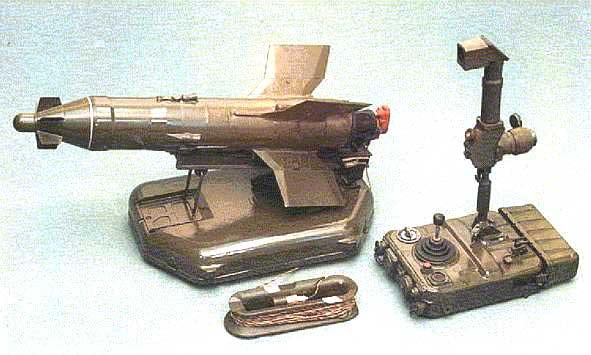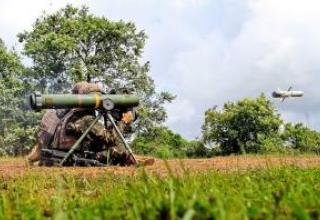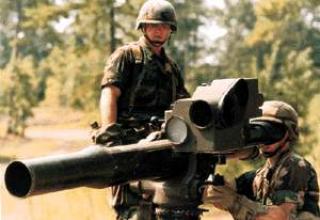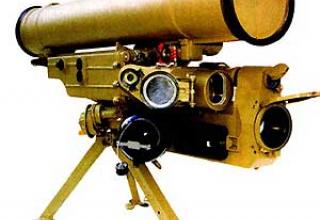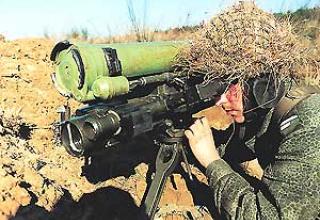Malyutka-2 antitank missile system is a modernized version of the 9K11 Malyutka system and differs from the last application of an improved missile with different types of warheads. It was developed at the Kolomenskoye Mechanical Engineering Design Bureau.
The system is designed to engage modern tanks and other armoured vehicles, as well as engineering structures such as DOT and DZOT in the absence and presence of natural or organized infrared interferences.
Its predecessor, the Malyutka Complex, was one of the first domestically produced PTRKs manufactured for about 30 years and is in service in more than 40 countries. Different variants of the complex were produced and are being manufactured in Poland, Czechoslovakia, Bulgaria, China, Iran, Taiwan and other countries. Among such copies are Susong-Po (DPRK), Kun Wu (Taiwan) and HJ-73 (China). ATM "Raad" - Iranian version of ATM 9M14 "Malyutka" in production since 1961. Iran has also developed a tandem cumulated BC with increased armor penetration, which is effective against multi-layer armor and armor under dynamic protection. The HMP proposes to extend the life of all previously launched missile variants, regardless of year and location of launch, by at least 10 years. "Malyutka-2 will make it possible not to dispose of its predecessors, but to upgrade them on the territory of the customer state. At the same time, the tank armour penetration rate is significantly increased, and the operator's work is facilitated by the introduction of interference-proof semi-automatic control. There is no need to retrain the calculations of complexes, as the principles of management are the same. The cost of modernization is half as low as the purchase of a similar new PTUR.
In the west, the system and its modifications received the designation AT-3 "Sagger".
Composition:
The "Malyutka-2" anti-tank missile system consists of a 9Sh16 optical vizier and a 9M14 anti-tank missile. The optical vizier has only a day mode. The complex is carried in three sights. One PU pack with an optical viewer, a battery and ZIP (mass 12.4 kg), the other two pack are 9M14 missiles with containers - launchers (mass 18.1 kg each). The combat calculation - 2-3 people.
Missiles board is extremely simplified and the main control functions are transferred to ground equipment, including the formation of control command, power supplies and receiving and amplifying devices. Transmission of the formed command and power supply is carried out on a special water-resistant three-stranded microcable with a length of 3200 meters, reinforced with thirty six silk threads. The reel with the cable is placed on the rocket and unwound during the flight. The control system is single-channel. The glider and housing of the missile's combat unit are made of special plastic, while the propulsion system, gyroscope, gas steering machines and the battle unit funnel are made of metal. This made it possible to significantly reduce the costs and production costs of the missile. Aiming at the target is semi-automatic or manual (by three points). At climatic tests the complex withstood without deformation the temperature of +50° for three months and could be stored for at least 10 years.
The "Malyutka-2" rocket has increased armor permeability and increased average flight speed. It can be used from all the regular launchers, is transported in the regular cappings and checked by the standard control and verification equipment of the complex "Malyutka". It is equipped with various types of combat units (cumulative, tandem cumulative, thermobaric) and an advanced track. Engine - double chamber RDTT has upgraded charging of marching and starting engines.
"Malyutka-2M" - version of rocket 9M14 with tandem cumulative unit has a special launcher with located on it controls and guidance of the rocket.
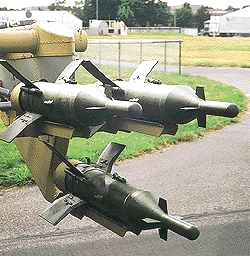
In addition to the portable version, an aviation version of the complex based on the Mi-8TV3 helicopter was developed.
Optical control equipment 9C428 is part of it:
- 9B332 operator panel
- automation unit 9B329
- junction box 9B351
- voltage stabilizer 9V119
- PTUR 9B452 testing device
- on-board control unit 9B453
The total weight of the equipment is 15 kg.
Characteristics:
| Range of fire, m | 400 - 3000 |
| Speed, gunshot/min. | 2 |
| The length of the rocket on the launcher, mm | 860 |
| Caliber, mm | 125 |
| Wingspan, mm | 393 |
| Malyutka 2 | |
| type of unit | cumulative |
| The length of the rocket in flight, mm | 1005 |
| rocket weight, kg | 12.5 |
| unit weight, kg | 3.5 |
| mean rocket speed, m/sec | 130 |
| armor permeability, mm | 800 |
| Malyutka-2M | |
| type of unit | tandem cumulative |
| The length of the rocket in flight, mm | 1005-1015 |
| rocket weight, kg | 13.5 |
| unit weight, kg | 4.2 |
| mean rocket speed, m/sec | 120 |
| armor penetration (behind active armor), mm | 720 |
| Malyutka-2F | |
| type of unit | thermobaric |
| The length of the rocket in flight, mm | 860 |
| rocket weight, kg | 12.0 |
| unit weight, kg | 3.0 |
| mean rocket speed, m/sec | 130 |
Testing:
MTUR "Malyutka" was very successfully used during the Arab-Israeli War in 1973, it was with its help that almost the entire Israeli tank fleet was destroyed - about 800 vehicles. Only on October 6, 1973, for example, the 252nd Israeli Tank Division was defeated - more than a hundred vehicles were hit.
Sources:
- А.В.Карпенко, С.М. Ганин "Отечественные авиационные тактические ракеты", "Бастион" N1, 2000г.
- MALYUTKA Anti-Tank Guided Missile System (Upgrade Options) /ROSOBORONEXPORT
